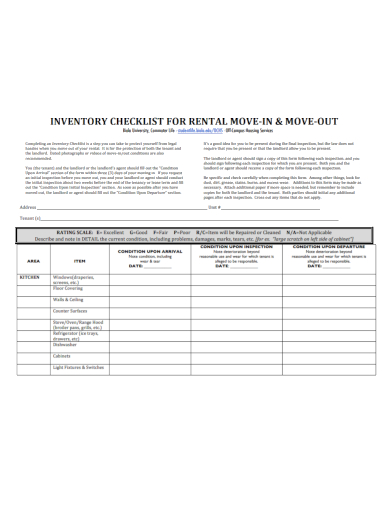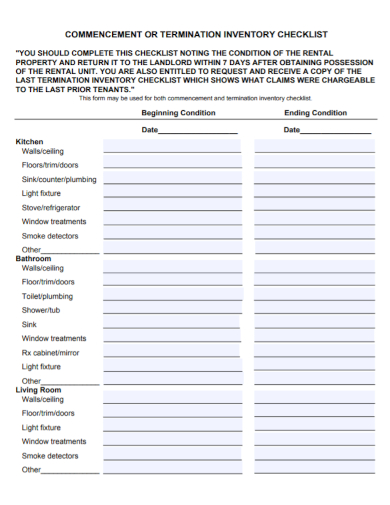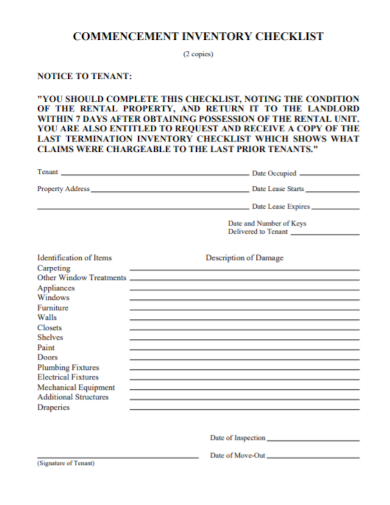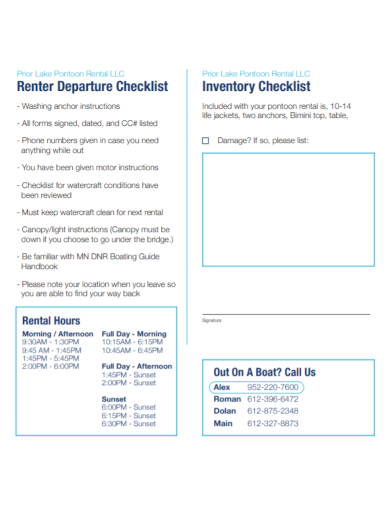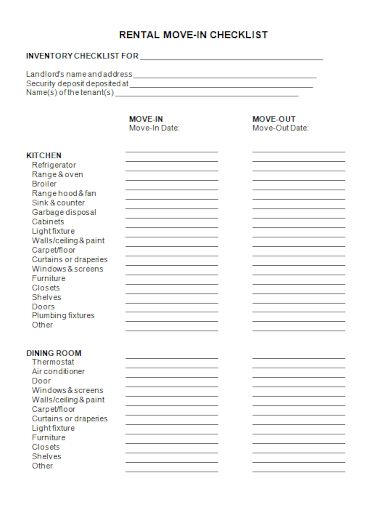Inventories are an important part of your rental business as a landlord since they could affect the condition and marketability of your property. For tenants who are moving out, an inventory checklist is also essential for tenants to check if all the objects in the property are complete and in good shape for them to get their deposit back. To help you do your inventory efficiently, a checklist is what you need. An inventory checklist lists down all the objects and fixtures in the rental property and records their condition. This is a great reference to use to address any issues regarding the property and to fix them before they get damaged. Read the article to know how to make a rental inventory checklist.
5+ Rental Inventory Checklist Samples
1. Rental Move In Move Out Inventory Checklist
2. Termination Rental Inventory Checklist
3. Commencement Rental Inventory Checklist
4. Rental Departure Inventory Checklist
5. Rental Inventory Inspection Checklist
6. Rental Move In Inventory Checklist
What is a Rental Inventory?
A rental inventory is a detailed report on the rental property and lists the furniture, fixtures, and fittings in every room, along with a description of their condition.
How to Make a Rental Inventory Checklist
1. Prepare Your Materials for Making the Checklist
Before you start checking the inventory, grab a writing instrument and a clipboard with paper attached or a notebook. You will need this to make your checklist. You can always transfer it on a word document after you’re done.
2. Take Inventory
It’ time to do the inventory. Walk around your rental space, room by room, and check all the inventory of each area. Create a table in your checklist and divide them into two columns. The first column must record the type of item in the property, and the next column should record its current condition. You can also add a column where you can put remarks of the item such as if it’s in faulty condition, you need to replace it right away.
Below are some examples of the items you can list down on your rental inventory checklist:
- Kitchen: Seasonings and condiments, tea and coffee, dishware, glassware, kettle and coffee machine, cookware, cooking utensils, food storage containers, cutting board, garbage can and trash bags, paper towels, cleaning solutions, dishwashing soap, and sponge.
- Bedroom: Sheets and linens, pillows, blankets, clothing hangers, curtains, alarm clock, lamps, light fixtures, bedside tables, and ceiling fan or air conditioning, wall heaters
- Bathroom: towels, toilet paper, soaps, shampoo, conditioner, garbage can, toothbrush, feminine products, shaving razors, and trash bags.
- Living Room: couches and chairs, TV, entertainment system, Décor, center and side tables, lighting, and lamps.
- Dining Room: Dining table, chairs, cabinets and shelves, table settings, lamps, and lighting.
Take your time to walk through and examine every piece of furniture, fixture, and object in each room. Be as thorough as possible and you can take some pictures of the conditions of other objects if they are not looking good. Make sure to note down the description of each photo.
Don’t forget to also check the condition of your rental property as well as you go through the inventory. Check to see if there are any:
- Damage to walls, ceilings, and floors
- Stains in curtains and carpets
- Any mold and mildew marks on walls, ceilings, furniture, or floors
- Damage to windows and doors
- Condition of each furniture whether if they are looking shabby and damaged or not
- Condition of cupboards, doors, and wardrobes if they are broken or not
- Condition of the electrical and gas appliances if they function properly
- Pressure on taps and quality of water
- Cracks in sinks and tiles
- Condition of the roof, gutters, and exterior walls
FAQs
What is the purpose of a rental inventory?
The purpose of a rental inventory is to protect both the landlord and the tenant from any legal dispute by listing all the contents of the rental property and recording the condition of each item inside the property as well as the condition of the property too.
Can tenants be charged for inventory?
Landlords aren’t allowed to charge tenants for mandatory inventory, and also cleaning and administrative fees. The only thing the landlords can charge tenants for is the rent, tenancy deposit, and holding deposit.
Does an inventory need to be signed?
Yes, the inventory must be signed, checked, and agreed upon by both the landlord and tenants before the tenants move into the rental property.
When you’re finished writing the checklist, print some copies for you to hand out to your tenant for you to both check the inventory of the property properly before you proceed with letting the tenant move in right away. This will help see if there are damages or missing things in the inventory and they can still be replaced before the tenants live in the property. Download our free sample checklist templates above for you to use as a reference on making your rental inventory checklist.
Related Posts
FREE 17+ Survey Checklist Samples in MS Word | Google Docs | PDF
FREE 18+ Background Checklist Samples in MS Word | Google Sheets | PDF
FREE 18+ Facilitator Checklist Samples in MS Word | Google Sheets | PDF
FREE 18+ Complaint Checklist Samples in MS Word | Google Sheets | PDF
FREE 18+ Internship Checklist Samples in MS Word | Google Docs | PDF
FREE 18+ Statement Checklist Samples in MS Word | Google Sheets | PDF
FREE 20+ Voluntary Checklist Samples in MS Word | Google Sheets | PDF
FREE 18+ Summary Checklist Samples in MS Word | Google Sheets | PDF
FREE 14+ Sponsorship Checklist Samples in MS Word | MS Excel | PDF
FREE 18+ Conference Checklist Samples in MS Word | Google Sheets | PDF
FREE 17+ Lesson Checklist Samples in MS Word | Google Sheets | PDF
FREE 18+ Progress Checklist Samples in MS Word | Google Docs | PDF
FREE 18+ Enrollment Checklist Samples in MS Word | Google Docs | PDF
FREE 18+ Graduation Checklist Samples in MS Word | Google Sheets | PDF
FREE 15+ Consent Checklist Samples in MS Word | Google Sheets | PDF

